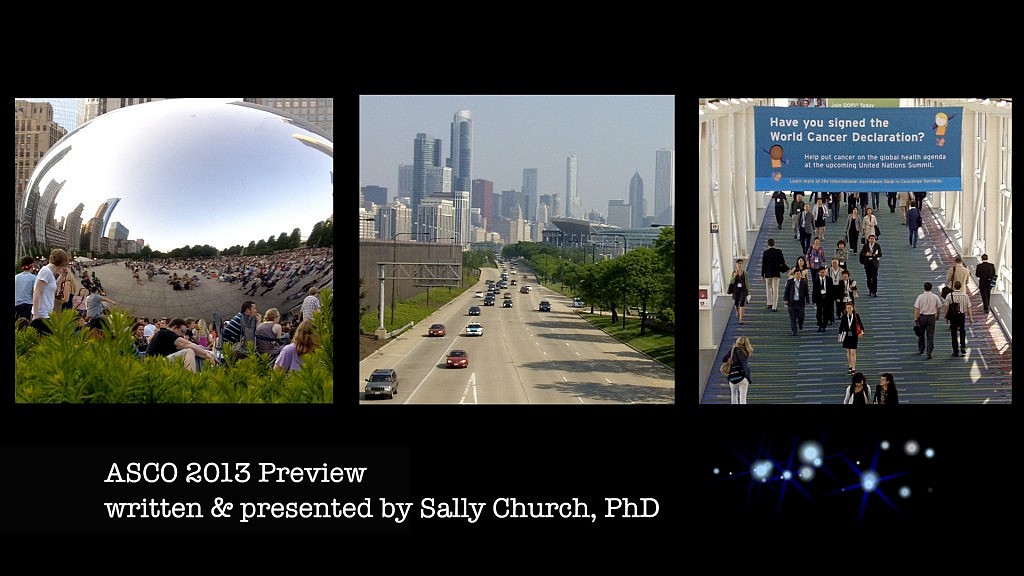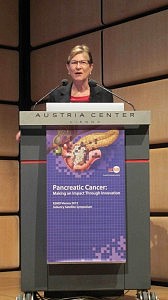Pancreatic cancer is one of those conditions I never hope to get. Why? Well, for starters, it’s one of the most difficult to treat tumour types, largely because so many patients are detected late, that is with stage IV metastatic disease. The annual incidence and prevalence are pretty much equal, suggesting that the for many with advanced disease, the lifespan is approximately one year or less. In fact, to put things even more succinctly, despite surgical resection, radiation and chemotherapy, more than 90% of people with pancreatic cancer do not survive beyond 5 years.
Over the last few decades we’ve seen a few incremental improvements from the original trials comparing 5FU (fluorouracil) and gemcitabine (GEM) to various gemcitabine based doublets and triplets such as oxaliplatin (GEM-Ox), docetaxel (GTX) and erlotinib. Things improved a little in 2010 though, with the landmark trial for FOLFIRINOX (5FU, leucovorin, irinotecan and oxaliplatin) being presented at ASCO, although the nasty toxicities involved tend to limit this regimen to fit patients with an excellent performance status being treated in Academia rather than the Community setting.
In between these two events, we saw multiple promising GEM-based doublets fail repeatedly after initial promising phase I/II data. It was a dismal period for pancreatic cancer researchers and clinicians.
With the advent of new data being presented at the recent ASCO Gastrointestinal meeting in San Francisco, I chatted with Dr Hedy Kindler (Associate Professor of Medicine, University of Chicago) who is well regarded as a pancreatic cancer expert and sees a large number of patients for this disease each year, about the advances in advanced pancreatic adenocarcinoma.
PSB: Very few of the doublets in combination with gemcitabine have succeeded, I think erlotinib was the only combination that got approved. So the first question to you is, what are you excited about now, what are the new things that are interesting in this disease?
Dr Kindler: The last time we spoke was in 2005 or 2006 – a lot has changed since then and Margaret Tempero summarized this very well today in her discussion about the changes over that period of time.
What did Dr Kindler like about the FOLFIRINOX data? Listen to the audio clip below to find out more:
Dr Kindler: Initially, the trial flew under the radar, many of us were not expecting that this was going to be such a positive trial. When we looked at the combination of these four drugs, it looked quite scarily toxic. For many of us, we chose our first few patients very gingerly. For me, my very first patient I used was a radiation oncology nurse in my center who I knew could be compliant, was performance status 0 and was incredibly healthy, and who I could monitor like a hawk.
Over time, I have learned that I can give this, not only to the perfect PS0 but to the PS1’s. I know that I can say with confidence to most patients, you can respond to this and we will gain disease control. We never had that with gemcitabine. You would expect after a few months that the disease would progress and they would feel minimally better. But now, we are seeing dramatic responses. We are extending this not only from metastatic, locally advanced, to many of those borderline resectable patients who are being transformed into resectable patients.
What is exciting with today’s meeting is that we are seeing that FOLFIRINOX Is not the only kid on the block and that the GEM/Abraxane data also shows activity. Certainly the Phase1/2 of GEM/Abraxane looked very exciting, but we’ve, all of us have learned that phase 2 results don’t always pan out to phase 3. It is very nice to see another regimen that shows activity. There is a caveat, 8.5 months is not 11.0 months. There is a difference between the two regimens, there is also a difference in the patient populations.
We can’t broadly say GEM/Abraxane is definitely inferior or definitely less toxic than FOLFIRINOX. As I look as how I am going to use the regimens, for the most part, the data today don’t change the fact that for most of my patients I am going to use FOLFIRNOX, because that is the regimen that has the higher response rate and that has the longer median survival, for most of my good performance status patients.
Will there be patients in whom I use GEM/Abraxane? I am eager to use it, l am eager to learn more about it, but I think it represents a new choice and not merely a new standard. Now I think what we are also going to learn over the future is that there will be certain patients who biologically it is better to use GEM/Abraxane, and as we get the SPARC data that may tell us. As we get other data on FOLFIRINOX we may determine that there are certain patients who should only get FOLFIRINOX. I think that is what we are going to learn over time.
There is still an unmet need of those patients who have a lesser performance status. Only 10% of the patients on the GEM/Abraxane study had a PS of 2, so I don’t feel comfortable extending utilizating that regimen in those patients yet, but there are a lot of PS2 patients who are under-served, who are going to still be getting only gemcitabine, in whom we now need to be looking at other palliative types of regimens and other approaches we can use to help those patients.
The fact that we have choices, that there are new regimens available and that it is not just one size fits all, I think is very exciting.
PSB: What about other gemcitabine based regimens such as GTX? Is that something that is in use commonly?
Dr Kindler: I certainly see GTX utilized in the Community, it is not a regimen of choice for me. I know it is a popular regimen in the Community. There have been many variations upon it, and it hasn’t been established in a phase 3. In fact, I saw a patient very recently treated in the community with GTX who had a PS of 0 and I was rather horrified that that PS0 patient had not received FOLFIRINOX, because I think she would actually have had less toxicity. That patient had a lot of toxicity but would have had a better outcome with FOLFIRINOX and that was based on phase 3 data.
I sense that there is still a lot of Community oncologists who are concerned about the toxicity of FOLFIRINOX, as I was initially, but as I have given it to more and more patients, and recognized – I see the patients on Day 1, first cycle 1 see them on Day 4, I see them on Day 8 – just that first cycle is challenging, so that the patient understands how they manage the diarrhea and other toxicities. Once I am comfortable that they are comfortable, then we just see them every other week.
As I am more comfortable giving this to more and more patients, I am really less intimidated by it, and so I am concerned there may be some people who are simply intimidated by it. You are comfortable with what you are comfortable with, you have a certain range of drugs, that you are used to giving and you are comfortable with it and it works well. Once you expand and try something else, you realize that’s not too bad. I hope people will feel more comfortable with regimens like that.
In terms of other GEM doublets, I think one thing the GEM/Abraxane data shows us is the validity of the meta analysis, which several years ago showed that patients with a good performance status do better with cytotoxic GEM doublets, whether it is GEM/CIS or whether it is GEM/OX or GEM/Cap there are subsets which do better with a GEM doublet, and we see that they have done better with this GEM doublet.
I hope that in the future we focus more on what is the biology, and not reflexively give gemcitabine +/- your drug here, as Jordan Berlin would say. Should you give GEM + this drug because it makes biologic sense, or should you give FOLFIRINOX + this drug or GEM/Abraxane + this drug, because it makes sense to do so from a biological stand point?
Are there subsets of patients, and maybe we should enrich? Your new wonderful targeted drug works only in patients with this wonderful target, so let’s enrich for this wonderful target and only offer that wonderful target to this subset of patients, and that happens to make sense to give with a FOLFOX based regimen so biologically we will give FOLFOX + or – your new wonderful target with said wonderful target.
I think we need to focus on that the way they are doing I-SPY in breast cancer and in other diseases.
PSB: Do you think that will happen in pancreatic cancer?
Dr Kindler: There have been many discussions about doing that. I think one problem in pancreas cancer is that it is not just a disease with one on/off switch. It is a very complex disease with much molecular heterogeneity. A very exciting, interesting presentation in the oral session today about the IL17A. That is a model, but if that is then brought out in patient systems, we may be able to target a subset of patients that way. There are many people who working on this and we hopefully will be able to. PANCAN has the goal of doubling the cure rate by 2020 and it may be achievable, but we’ll have to work pretty hard.
And finally…
The critical SPARC expression data for the phase III MPACT trial of Abraxane plus gemcitabine wasn’t available at this conference, but the presenter, Dr Daniel von Hoff assured me that it will be at ASCO in June. This analysis will potentially be critical in informing physicians whether those patients with high SPARC expression do better than those with low SPARC expression. The poster presented at this conference was based on an overall analysis of all patients, regardless of the biomarker.
Not yet on our free mailing list for the forthcoming Cancer Reports? Sign up below!
The inaugural report goes out later this month on advanced Pancreatic Adenocarcinoma, where I’ll be providing deeper insights and analysis relating to the market landscape and what the potential new developments with Abraxane, masitinib and S1 mean to both the Academic and Community settings:



 One of the most interesting highlights of this ESMO for me has actually not been some new data or science that was presented here, but the sense of anticipation about the forthcoming nab-paclitaxel (Abraxane) data in pancreatic cancer.
One of the most interesting highlights of this ESMO for me has actually not been some new data or science that was presented here, but the sense of anticipation about the forthcoming nab-paclitaxel (Abraxane) data in pancreatic cancer.
 Fast forward two years and there has been a new paper in Cancer Discovery by a different group (see Frese et al., (2012) from the University of Cambridge in the references) looking at the mechanistic role of nab-paclitaxel in pancreatic adenocarcinomas.
Fast forward two years and there has been a new paper in Cancer Discovery by a different group (see Frese et al., (2012) from the University of Cambridge in the references) looking at the mechanistic role of nab-paclitaxel in pancreatic adenocarcinomas.